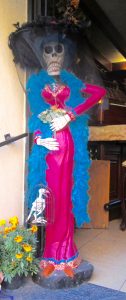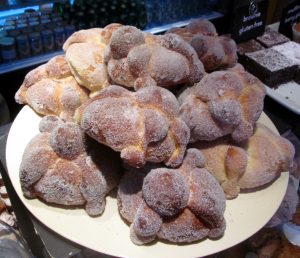These are the days of miracle and wonder… when boney old Catrinas re-emerge from their skeleton closets, when bright orange marigolds festoon the markets and doorways, when families erect elaborate altars in honor of their long-dead loved ones and tempt them to return for a brief but joyful visit by offering favorite drinks and food.

Yes, the annual Day of the Dead festivities have arrived here in San Miguel de Allende, as well as other cities, towns, and pueblos throughout Mexico.
As I wrote in my WOW photo essay, “A Day in the Life of Day of the Dead,” posted on November 3rd last year:
“What began several thousand years ago among the indigenous peoples of Mexico, Día de los Muertos (Day of the Dead), November 2nd on the calendar, has since grown to become an enormous fusion of pre-Hispanic and Christian religious traditions – a colorful explosion of life-affirming joy meant to demonstrate love and respect for dead loved ones. In this gringa’s long life experience, there’s simply nothing like it.”
Often misinterpreted as Mexico’s equivalent of Halloween, the Day of the Dead is a time to welcome and commune with the dead, not fear their return. In fact, writes Aldo Ibarra, a lecturer on Mexico’s culture and traditions:
“The nationwide celebration of Day of the Dead holiday in Mexico has been recognized by UNESCO as a part of the Intangible Cultural Heritage of Humanity, a list of cultural practices around the world that the U.N. believes represents the cultural heritage of the human race.”
One of the most iconic items placed on Mexican families’ Day of the Dead altars is pan de muerto (bread of the dead), a sweet, light, eggy, buttery yeast bread similar to brioche, which is normally formed into hand-size round buns with decorative bones and skulls crisscrossed on top, then sprinkled with sugar after it’s baked — to represent the dirt that covers a dead person’s coffin.

So if you cannot be in Mexico to appreciate the joyful, colorful sights of this celebration first-hand and to taste the pan de muerto made fresh in your nearest panaderia, you could always try making this delicious Day of the Dead bread at home and let it transport you and your own family. It might even summon some ancestors.
Day of the Dead Bread
(This step-by-step recipe, adapted from the October 2015 issue of Bon Appetit, makes one loaf. You can also make several small loaves [buns] or divide the dough into thirds to make a braid.)
INGREDIENTS
- 1 ¼-ounce envelope active dry yeast (about 2¼ teaspoons)
- 5⅓ cups all-purpose flour, divided
- 6 large eggs
- 1¼ teaspoons kosher salt
- 1 teaspoon orange-flower water (or the grated zest of 1 orange)
- ¾ cup sugar, plus more for sprinkling
- ¾ cup (1½ sticks) unsalted butter, softened, plus 6 tablespoons melted, divided
- Nonstick vegetable oil spray
RECIPE PREPARATION
- Mix yeast, ⅓ cup flour, and ¼ cup warm water in the bowl of a stand mixer with a wooden spoon or spatula until a sticky dough forms. This is your starter. Let rest, uncovered, in a warm, draft-free area until starter looks very loose and bubbles are forming on top, about 35 minutes.
- Whisk eggs, salt, orange-flower water (or orange zest), and ¾ cup sugar in a medium bowl until foamy and sugar begins to dissolve, about 1 minute. Add egg mixture and remaining 5 cups flour to starter and mix with a dough hook on medium-low speed, adding ¾ cup softened butter a few pieces at a time, until a soft dough forms, about 5 minutes. Increase speed to medium and continue mixing until sugar is dissolved and dough is shiny and elastic, about 10 minutes (dough will be very sticky).
- Lightly brush a large bowl with 2 Tbsp. melted butter. Transfer dough to bowl. Cover with plastic wrap and let rise in a warm, draft-free area until almost doubled in size, about 2 hours.
- Line 2 rimmed baking sheets with parchment paper; coat parchment with nonstick spray. Turn out dough onto a clean work surface, then cut off a baseball-sized piece of dough (about one-quarter of the dough). Using your hands, re-shape the larger piece into a smooth round ball and transfer to the center of a prepared sheet. Roll smaller piece into an 8″-long log, then divide into 4 equal lengths. Shape one of those lengths into a ball and place on second prepared sheet 3″ from the edge.
- Roll another length of dough with the palm of your hand into an 8½”-long rope, pressing out from the center so the middle is thinner and both ends are knobby, resembling a bone. Place on prepared sheet a few inches away from smaller ball. Repeat with remaining 2 pieces of dough, transferring to sheet as you go. Brush all 5 pieces of dough with 2 Tbsp. melted butter and loosely cover with plastic wrap. Let rise in a warm, draft-free area until almost doubled in size, about 1½ hours.
- Preheat oven to 325°. Remove plastic wrap and carefully pick up one of the bones, lifting from the ends (it will stretch and deflate slightly). Drape over large dough round, positioning at 10 o’clock and 4 o’clock. Repeat with second bone, positioning at 2 o’clock and 8 o’clock. Position third bone at 12 o’clock and 6 o’clock. Carefully place smaller ball in the center, at point where bones overlap, gently pressing edges of ball into bones and larger ball, crowning the loaf.
- Bake bread until browned and it sounds hollow when tapped with your fingertips, 40–50 minutes. Working in sections, brush one-quarter of the loaf with melted butter and immediately sprinkle with sugar so that it sticks. Repeat with remaining sections and butter. Let cool on a wire rack at least 1 hour before slicing.
~ ~ ~
For more vibrant photos from my previous reports on San Miguel’s Day of the Dead celebrations, please search the WOW archives for “A Day in the Life of Day of the Dead” (Nov. 3, 2018), “Calaca Days” (Nov. 4, 2017), and “Days of the (Almost) Dead” (Nov. 3, 2016).
